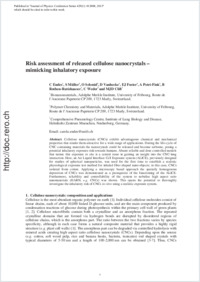Risk assessment of released cellulose nanocrystals – mimicking inhalatory exposure
- Endes, Carola Bionanomaterials, Adolphe Merkle Institute, University of Fribourg, Switzerland
- Müller, S. Polymer Chemistry and Materials, Adolphe Merkle Institute, University of Fribourg, Switzerland
- Schmid, O. Comprehensive Pneumology Centre, Institute of Lung Biology and Disease, Helmholtz Zentrum Muenchen, Neuherberg, Germany
- Vanhecke, Dimitri Bionanomaterials, Adolphe Merkle Institute, University of Fribourg, Switzerland
- Foster, E. Johan Polymer Chemistry and Materials, Adolphe Merkle Institute, University of Fribourg, Switzerland
- Petri-Fink, Alke Bionanomaterials, Adolphe Merkle Institute, University of Fribourg, Switzerland
- Rothen-Rutishauser, Barbara Bionanomaterials, Adolphe Merkle Institute, University of Fribourg, Switzerland
- Weder, Christoph Polymer Chemistry and Materials, Adolphe Merkle Institute, University of Fribourg, Switzerland
- Clift, Martin J. D. Bionanomaterials, Adolphe Merkle Institute, University of Fribourg, Switzerland
-
10.04.2013
Published in:
- Journal of Physics: Conference Series. - 2013, vol. 429, no. 1, p. 012008
English
Cellulose nanocrystals (CNCs) exhibit advantageous chemical and mechanical properties that render them attractive for a wide range of applications. During the life-cycle of CNC containing materials the nanocrystals could be released and become airborne, posing a potential inhalatory exposure risk towards humans. Absent reliable and dose-controlled models that mimic this exposure in situ is a central issue in gaining an insight into the CNC-lung interaction. Here, an Air Liquid Interface Cell Exposure system (ALICE), previously designed for studies of spherical nanoparticles, was used for the first time to establish a realistic physiological exposure test method for inhaled fiber shaped nano-objects; in this case, CNCs isolated from cotton. Applying a microscopy based approach the spatially homogenous deposition of CNCs was demonstrated as a prerequisite of the functioning of the ALICE. Furthermore, reliability and controllability of the system to nebulise high aspect ratio nanomaterials (HARN, e.g. CNCs) was shown. This opens the potential to thoroughly investigate the inhalatory risk of CNCs in vitro using a realistic exposure system.
- Faculty
- Faculté des sciences et de médecine
- Department
- Département de Chimie
- Language
-
- English
- Classification
- Biological sciences
- License
-
License undefined
- Identifiers
-
- RERO DOC 118084
- DOI 10.1088/1742-6596/429/1/012008
- Persistent URL
- https://folia.unifr.ch/unifr/documents/303083
Statistics
Document views: 106
File downloads:
- pdf: 140
